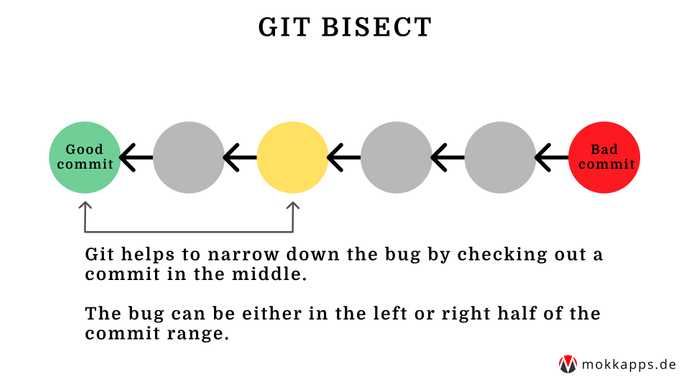An Interest In:
Web News this Week
- April 1, 2024
- March 31, 2024
- March 30, 2024
- March 29, 2024
- March 28, 2024
- March 27, 2024
- March 26, 2024
Use Git Bisect to Find the Commit That Introduced a Bug
As a developer you know that situation: the code worked like a charm and suddenly there is a bug but you have no idea where and when it was introduced.
If you are working in a big team the chances may be quite high that many commits have been added in the meantime. So finding the commit where the bug was introduced can become quite nasty.
Luckily, Git offers a tool that helps to detect the first bad commit that introduces the bug. It is called git bisect.
How does it work?
We need to provide Git Bisect two information to be able to identify
- A good commit where the bug was not present.
- A bad commit where the bug is present.
This way Git knows that the bug has to between the good and the bad commit. Starting the bisect process will split the range of commits between the good and bad commit in half and check out a commit in the middle:
Our task is now to validate the code at this commit. This can be done by compiling, running the application or launching a test case for the given bug. Next, we need to tell Git if the test was good or bad. Git will simply repeat this process until weve singled out the commit that contains the bug.
The used algorithm is called binary search.
Practical Example
Lets look at how we can run Git Bisect from the command line. First, we need to start the process
$ git bisect startNext step is to provide Git a good and bad commit. The bad commit is often the current state which refers to HEAD:
$ git bisect bad HEADTo be able to find good commit you need to check out any older revision where you are quite sure that the bug did not exist. After you have checked it out and verified that the bug is not present there, we provide Git the corresponding commit hash :
$ git bisect good acd72832Now we are ready to start the bisecting process. Git will check out a commit in the middle of the range between the good and bad commit we provided:
Bisecting: 6 revisions left to test after this (roughly 2 step)[commit_ABC] Added controllerAt this point we need to verify if the bug is still present or not. If it is still present we need to run
$ git bisect badotherwise we run
$ git bisect goodto mark it as good.
Depending on the result, Git will again split the original commit range and select either the first or second half. It will again check out a commit in the middle and we need to verify if the bug is present there.
This process is repeated until weve successfully singled out the bad commit!
Once weve found the culprit, we can end the bisect process by running:
$ git bisect resetGit will then finish the bisect process and take us back to our previous HEAD revision.
Conclusion
Git Bisect can be a helpful tool to track down a bug. I only use git bisect when I absolutely have no idea where the bug was introduced and I need to search through a lot of potentially unrelated changes.
For more information about Git Bisect take a look at the official docs.
If you liked this article, follow me on Twitter to get notified about new blog posts and more content from me.
Original Link: https://dev.to/mokkapps/use-git-bisect-to-find-the-commit-that-introduced-a-bug-2j3b
Dev To
 An online community for sharing and discovering great ideas, having debates, and making friends
An online community for sharing and discovering great ideas, having debates, and making friendsMore About this Source Visit Dev To



